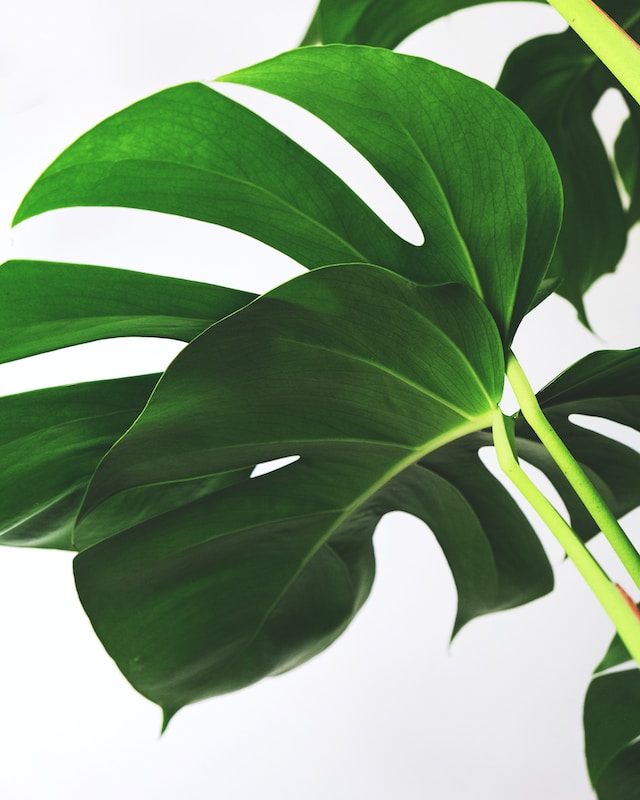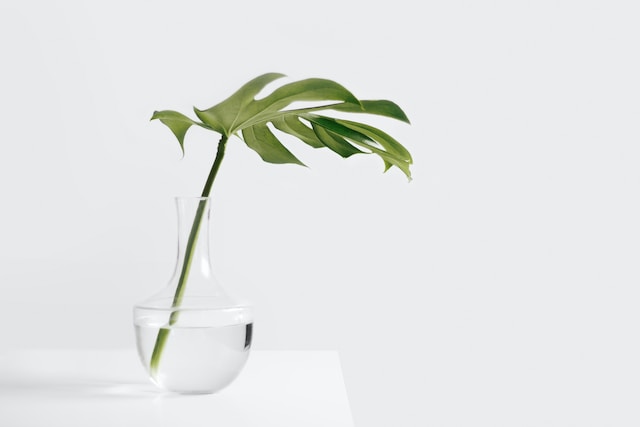Propagation, the art and science of creating new plants from existing ones, is a captivating journey into the world of botanical reproduction. When looking to propagate indoor plants, there are a few things you need to know.
In this guide, we will not only explore the general principles of propagation but also provide detailed steps and tips to propagate specific indoor plants such as Rubber plants, Aloe Vera, Calathea, Monstera, Philodendron, Fiddle leaf Fig, English Ivy, air plants, and Ficus.
The Science of Indoor Plant Propagation:
Propagation, the art of creating new plants from existing ones, is a fascinating science, all about the intricate processes of plant reproduction.
To truly appreciate your plant’s ability to revive its lost limbs, it’s essential to understand the underlying science that allows plants to multiply and thrive.
1. The Role of Hormones:
At the heart of plant propagation lies the orchestration of growth hormones, particularly auxins.
Auxins are chemical messengers produced by the plant, primarily in the tips of shoots and roots. They play a pivotal role in stimulating cell division, elongation, and differentiation.
When a plant undergoes stress or injury, auxins are redistributed to areas where new growth is needed.
2. Meristematic Tissues:
The secret to a plant’s regenerative power lies in meristematic tissues – regions of the plant where cells continuously divide.
Apical meristems, found at the tips of stems and roots, are responsible for vertical growth. Lateral meristems, which include the cambium layer, contribute to the plant’s girth.
These tissues are crucial during propagation as they give rise to new roots, shoots, and leaves.
3. Root Development:
When a cutting is taken from a parent plant, the presence of auxins encourages the formation of adventitious roots.
These roots emerge from locations other than the traditional root system, establishing a connection with the soil to absorb water and nutrients.
The development of roots is a critical phase during propagation, and the right balance of hormones and environmental conditions is essential for success when you propagate indoor plants.
4. Shoot Growth:
Simultaneously, the cutting or divided section of the plant initiates the development of new shoots.
Apical dominance, a phenomenon where the tip of the shoot inhibits the growth of lateral buds, is a natural mechanism in many plants.
However, during propagation, this balance can be manipulated to encourage the growth of multiple shoots, resulting in a bushier and more vigorous plant.
5. Genetic Continuity:
Propagation ensures genetic continuity by creating new plants that are genetically identical to the parent plant.
This is particularly evident in methods like division and cuttings, where the genetic material from the original plant is preserved.
The cloned nature of propagated plants allows for the replication of desired characteristics, such as vibrant foliage, unique shapes, or specific traits.
6. Environmental Factors:
The success of propagation is not solely dependent on genetic factors but is also influenced by the environment.
Adequate light, humidity, temperature, and nutrient levels are crucial for the proper development of roots and shoots. Creating a microenvironment that mimics optimal conditions is key to supporting the propagation process.
7. Seasonal Timing:
Plants are inherently attuned to the seasons, and the timing of propagation plays a significant role.
The growing season, typically spring and early summer, is when plants are actively producing new growth. Performing propagation during this period aligns with the plant’s natural rhythm, enhancing the chances of success.

The primary methods to propagate indoor plants
Now that we know all about the science, let’s take a look at three primary methods of propagation, with this knowledge, you’ll be set to be able to propagate most indoor house plants with ease successfully.
Division
What is Division?
Division involves separating an existing plant into two or more sections, each capable of growing independently.
This method is often suitable for propagating indoor plants with multiple stems or bulbs, like snake plants or calatheas.
How to perform Division:
- Select a Healthy Parent Plant: Ensure the parent plant is robust and free from diseases.
- Gently Remove from Pot: Take the plant out of its pot, being careful not to damage the roots – or get soil everywhere.
- Separate Sections: Gently separate the roots and divide the plant into sections, ensuring each section has roots attached.
- Plant in Individual Pots: Plant each section in its pot with fresh potting mix. If you want to go the extra step, you can tailor the soil types to what works best for your plant – more on this later.
- Water and Care: Water the newly potted sections according to what your plant needs, and provide proper care for root development.
Taking Cuttings:
What is the process for taking good cuttings?
Taking cuttings involves snipping a part of a healthy plant to encourage root development and create a new, independent plant.
This method is suitable to propagate various indoor plants and allows for genetic replication.
How to Take Cuttings:
- Choose a Healthy Stem or Leaf: Select a healthy, disease-free stem or leaf for cutting.
- Use Sharp Tools: Use clean, sharp shears or scissors for a precise cut, and avoid damaging the plant tissue unnecessarily.
- Take the Cuttings: Cut just below a node, ensuring the cutting has at least one or two nodes. (Nodes are the small knots in the stem from which leaves may sprout).
- Apply Rooting Hormone: Dip the cut end in rooting hormone to stimulate root growth.
- Plant in Potting Mix: Insert the cutting into well-draining potting mix, or water, depending on what you have available, and the type of plant, as some plants will sprout roots in water, however, some will only develop roots in dirt.
- Provide Care: Maintain appropriate humidity, light, and moisture for optimal root development.
Leaf Cuttings:
How is Leaf Cutting Different?
Leaf cuttings involve using a single leaf to create a new plant. This method is common for plants like fiddle leaf figs and snake plants, where each leaf has the potential to give rise to a new individual.
How to Take Leaf Cuttings:
- Select a Healthy Leaf: Choose a healthy, mature leaf with no signs of disease.
- Remove Leaf Carefully: Gently remove the leaf, ensuring it has a short stem attached.
- Allow to Dry: Let the cut end dry for a day to prevent rot.
- Plant in Mix: Plant the leaf, cut side down, in a well-draining potting mix.
- Water Sparingly: Water lightly until roots develop, then gradually increase.
Specific Indoor Plant Propagation:
Now, let’s explore how to propagate specific indoor plants using these methods.
Items You’ll Need:
Before you begin, gather the following essentials:
- Pruning shears or scissors
- Rooting hormone
- Well-draining potting mix
- Containers or pots
- Misting bottle
- Clear plastic bags or plastic wrap
- Watering can or spray bottle
- Grow lights or indirect sunlight
- Temperature control
Understanding the Cutting Process:
Before making your cut, know where and how to take it. Each plant type has specific requirements. Here are examples of a few common indoor plants for propagation.
1. Rubber Plant (Ficus elastica):
- Take Cuttings: Snip a healthy stem just below a leaf node.
- Rooting Time: 4-6 weeks.
- Planting: Insert the cutting into a well-draining mix.
2. Aloe Vera:
- Take Offsets: Separate offsets from the main plant.
- Rooting Time: 2-4 weeks.
- Planting: Plant offsets in a succulent or cactus mix.
3. Calathea:
- Take Division: Divide the plant at the roots.
- Rooting Time: 4-6 weeks.
- Planting: Plant divisions in a peat-based mix.
4. Monstera (Monstera deliciosa):
- Take Stem Cuttings: Snip a healthy stem with a few nodes.
- Rooting Time: 2-4 weeks.
- Planting: Plant cuttings in a well-aerated mix.
5. Philodendron:
- Take Cuttings: Snip a healthy stem just below a leaf node.
- Rooting Time: 3-5 weeks.
- Planting: Plant cuttings in a well-draining mix.
6. Fiddle Leaf Fig (Ficus lyrata):
- Take Leaf Cuttings: Snip a healthy leaf with a stem.
- Rooting Time: 4-6 weeks.
- Planting: Plant cuttings in a mix with added perlite.
7. English Ivy (Hedera helix):
- Take Cuttings: Snip healthy stems with leaves attached.
- Rooting Time: 2-4 weeks.
- Planting: Plant cuttings in a mix with good drainage.
8. Air Plants (Tillandsia):
- Division: Separate offsets or pups from the parent plant.
- Rooting Time: 2-4 weeks.
- Planting: Attach air plants to a substrate like bark or driftwood.
9. Ficus:
- Take Cuttings: Snip a healthy stem just below a leaf node.
- Rooting Time: 3-5 weeks.
- Planting: Plant cuttings in a well-draining mix.
Tips and Tricks:
- Timing is Crucial: Propagate indoor plants during the growing season (normally spring/summer)
- Healthy Parent Plants: Select only healthy, disease-free indoor plants to propagate.
- Use Sharp Tools: Clean, sharp tools for precise cuts, and avoid damaging your plants more than necessary.
- Humidity Matters: Maintain high humidity for tropical plants, this can be achieved various ways, such as misting them occasionally.
- Patience is a Virtue: Be patient and observe progress. It may take multiple weeks to see visible progress.
- Experiment with Propagation Mediums: Test different substrates, chemical mixtures and environments to see what helps your plants thrive best.

Beware when you Propagate Indoor Plants with Trademarked Genes to Sell:
While propagation is a fulfilling hobby, it’s important to be aware of legal considerations, especially when it comes to whether you want to propagate indoor plants with trademarked or patented genes.
Some plants have specific genetic traits that are protected by intellectual property laws. This means that propagating and selling plants with patented or trademarked genes without permission is prohibited.
Key Points to Consider:
- Research Plant Varieties: Before propagating and selling, research the specific plant variety to identify any trademark or patent information.
- Respect Intellectual Property Rights: If a plant is protected, refrain from selling propagated plants without proper authorization.
- Permission and Licensing: If you intend to sell plants with patented or trademarked genes, seek permission from the appropriate authorities or obtain the necessary licensing.
- Educate Yourself: Stay informed about intellectual property laws related to plant varieties in your region.
Propagation is a rewarding skill that allows you to expand your indoor garden. By understanding the unique characteristics of each plant, you can embark on a journey of creating new life and enhancing the greenery in your living space. Take a look at our other guide on the secrets of successful gardening, to gain a full understanding of all things plants!
